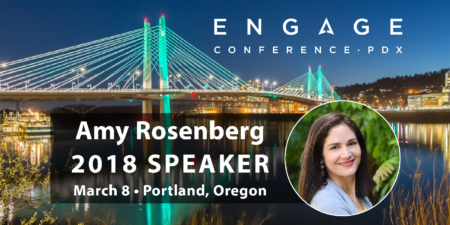Amy Rosenberg will be speaking on PR at Engage 2018, which will take place March 8th, 2018 in Portland, Oregon. For more information or to purchase tickets, please click here.

1) Please give us your background and let us know what you do for a living.
I run client strategy for a PR firm that focuses on traditional and digital earned media, called Veracity. We keep clients well-positioned in the press in an increasingly busy marketplace. Before starting Veracity 8 years ago, I was a top-producing real estate broker during a break from my marketing career. I had managed clients in the PR departments of two well-known advertising agencies serving hallmark Pacific Northwest organizations.
2) In the digital age, everybody is visible. How can someone use PR to make themselves more visible to their targeted audience?
It’s not necessarily about getting more exposure, its about getting the right kind of exposure. We can shamelessly promote through blog posts and social media. But the more often we do that the less often our audience will listen. With all of the chatter online, it’s more important to get other people talking about you or your company rather than doing it yourself.
Yet, press coverage takes this idea of third-party endorsements to the next level. While our current administration might disagree, people still trust what the press has to say, especially B2B and trade press. Press mentions are viewed as more credible than a nod from Gossipy Gail. However, the most important point is that the search engines still treat links from media outlets as more credible—influencing SEO on a deep organic level that seems to be everlasting.
But I haven’t really answered your question. How can you use PR for visibility among targeted audiences? First you’ve got to get PR in the right places. What are your audiences paying attention to? Study those outlets. Think about how you can get their attention. Reach out to the reporters/editors with your ideas in the manner that you’d reach out to any partner or prospective client with an idea. Never reach out more than twice. If it’s not working, change your idea and/or targeted contact.
Once you actually get the press coverage, this is where the magic begins. Not only is your SEO already better, you can use this coverage as classy promotion. Follow up with new business leads or current customers by sending them the link to the coverage in an email as an FYI, include it in your newsletter, and of course promote it through your blog and social channels. It’s a promotional game changer because you’re still not flaunting your greatness, you are simply showing the world what someone else thinks about you or your company by publicly thanking the outlet and contact for the kind coverage.
3) How can one determine ROI from a PR effort?
PR is actually mostly used for branding. Just like unveiling a new logo, how do you point back to increased sales because of it? PR can be the secret weapon to move very expensive items, make life-altering decisions, sway public opinion, or ink a lengthy business deal. There is no one thing that causes these decisions to be made. They all likely started with a referral from a trusted personal source (not press). Then PR coverage brings that referral along to the closing phase. We couldn’t really ever prove the PR coverage affected the decision unless we were inside the minds of the decision-maker.
However, here are the 2 classic responses you’ll hear from other PR people:
1: Track all the coverage you get, find out what it would take to buy that coverage through advertising and multiply that amount by 3-5 (this is called a “publicity rating” per the Public Realtions Society of America (PRSA)) to factor in the idea that press coverage is more credible than advertising (because anyone can buy an ad). Veracity uses a conservative multiplication factor of 3.
2. Just because you got this coverage cheaper than if you were to buy it, you still can’t say that revenue increased because of it. However, you could track sales based on when the press coverage hit. Some magazines are getting pretty savvy with creating promo codes for items they include in their coverage. If a landing page is created for the online portion of the magazine to link to, then you can track orders coming in from that landing page. See past case studies for an example of using a code here or tracking sales believed to be influenced by PR work here.
Todd Mintz knows PPC…knows Social Media…knows SEO…knows Blogging…knows Domaining…and knows them all real well. He runs growth marketing for )and is also a Director & Founding Member of SEMpdx: Portland, Oregon’s Search Engine Marketing Association, and he can be found here on Twitter and Facebook.
